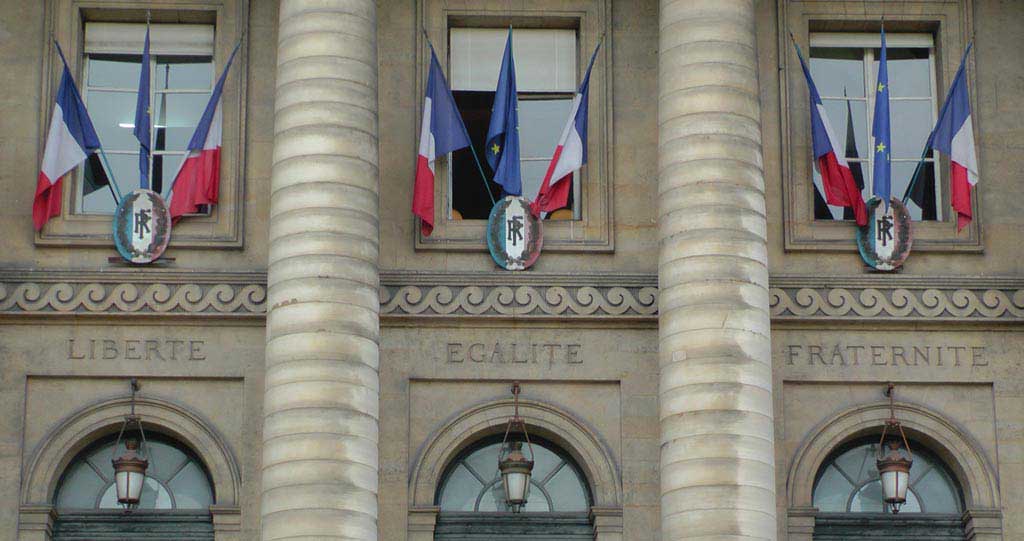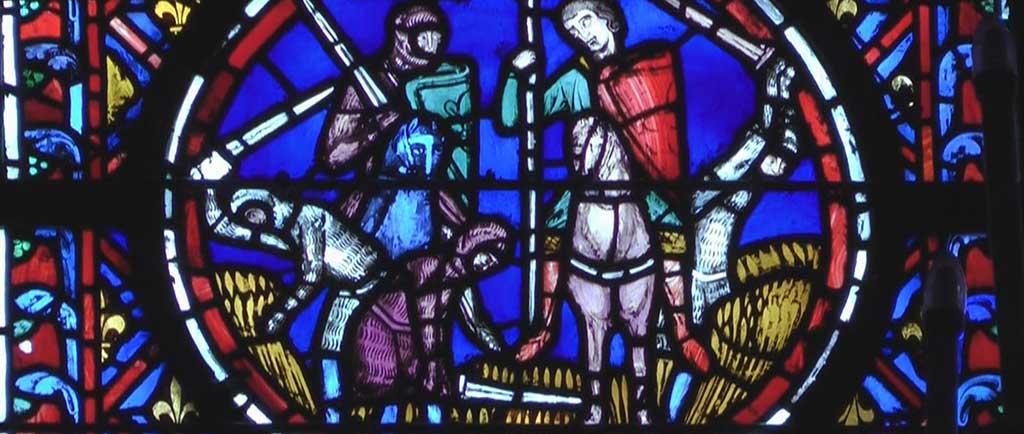One of the most impressive experiences for our trio during our six week tour of France, was history at our fingertips (and under our toes) – especially mine. As we explored only a few of the ancient cathedrals, elaborate stone churches and Cathar castles, we had no idea how profound an experience it would be sensing the past by, literally, feeling it.
My personal desire to visit France was partly in order to grab faint visual mementos of medieval landscapes before my fading sight sank so far below the horizon that their beauty would become blackened by the encroaching shadows of perpetual darkness. What I managed to see took my breath away: what I managed to touch enlivened the seeing.
Our trio venture further into the heart of old Paris known as La Cité, to see the churches of Sainte-Chapelle and Notre Dame. The summer sun shines down on the vibrant collection of streets teeming with foreign tourists, street artists selling etchings of Paris landscapes, stalls decked out with felt berets, silver statues, and boxes of jingling Eiffel Tower keyrings.
I cling to my men-folk, tap-tapping my cane as we go. On arrival at the 13th century chapel, security guards check every single bag and coat pocket – Harry is asked to relinquish his Swiss pocket knife. The guard makes it very clear: if he does not hand over the compact assortment of boy-scout tools, he is prohibited to enter the chapel. Rubbing his hand over the precious item in question (a present from his father), Harry decides he cannot surrender the childhood keepsake and toss it into the guard’s waiting bin. He will wait outside.
We have travelled all this way to see the spectrum of coloured glass inside the Holy Chapel of Sainte-Chapelle (commissioned by King Louis IX in 1239). How can we possibly enjoy the experience without Harry? Delaying the movement of the queue behind us as we deliberate about what to do, the guard kindly offers to mind Harry’s Swiss knife, promising to return it after our tour and ushers us briskly through the security barrier opening out onto the stone courtyard of the old palace.
Tap-tap-tap goes my cane over grey stone as anticipation mounts with every step closer toward the only surviving building of the Royal Capetian era. Quietly we file in. The immediate smoky fragrance of burning rosemary and frankincense ushers us with respectful silence through the dimly-lit lower chapel. We glide with the throng of sight-seeking devotees and shuffle up narrow steps to a second floor. It is here, when my feet feel the buckled curves of the wooden stairs, concaved through the centuries by thousands of pilgrims’ shoes, that I sense we are taking a very special step back into history.
As we enter the upper chapel, not even vision-impaired eyes can fail to see the brilliant rainbow hues streaming down from the stained-glass windows. Mike nudges close to my side as we gaze upwards and trace the giant panels of 13th century coloured glass that fill the entire nave. My awestruck son tries to describe in low whispers, as his eyes travel over the intricate pictures painted within gilded glass on the fifteen panels, but can only say, oh, WOW! – over and over again. I smile, happy to know my son is viewing the magic of the glass and I am content to imagine its intricate beauty.
With the light of day contrasting in the background as if we are inside a giant kaleidoscope, we stare together, in awe at the deep blue and purple, red and yellow patches of glass emanating from all four walls. Harry sidles to our side and enlightens us to the fact that the large panels depict in sequential order the various narratives of the Christian Bible. While Harry points out specific windows depicting the holy saints and martyrs to an awestruck Mike, I close my eyes to feel the history as I only know how – by imagining it.
Firstly, I remind myself that we are treading upon the same stone tiles where once stood ordained priests and bishops of the 13th century! If the priest in his holy attire were to be standing at his altar this very morning, what would he say to this idolatrous crowd dressed in casual jeans, gym shoes and t-shirts? Would my black skirt and royal-ruby coat grant me pardon to attend mass alongside the King or would we all be condemned to hell?
With this thought, I slink into a darker alcove, imagining a white-robed priest genuflecting on a grey stone slab by the altar, waving purifying frankincense, granting forgiveness for all the sins of the inhabitants of the palace. Then, a purple-robed priest might have made his way slowly towards the altar, adorned by saintly statues and marble vases, the rose stained-glass window above, God’s all-seeing eye watching over prayerful preceedings. I wonder where Louis IX may have sat, admiring his treasure-trove of precious relics, including the Crown of Thorns he paid a King’s ransom for in 1239.
People shuffle in and mill around me as I stand motionless – ears poised to pick up the faint drone of hallowed music seeping from ancient wooden beams. The sound of priests chanting mantras, the sacred text filling this house of prayer with devotional song, lingers – if only one could really hear it!
It is hard to leave this rainbow bathed-room, but we regroup and make our way slowly down the buckled wooden stairs once more: sweeping gently with my cane so as not to punch a round groove into the thinning steps. To our surprise, the security guard greets us and hands Harry his Swiss knife – which is placed swiftly into his camera bag. We move on to see Notre Dame – the cathedral that took two hundred years to build.
The Cité is buzzing with adoring foreigners, the sky is a clear cornflower-blue, happy vibes fill the air. As I trot alongside Harry and Mike, not only am I trying to keep up with their long strides and excited conversation but every other sensory cell is on high alert to take in the ‘sights’ of Paris. As we dodge random human traffic, darting about without any rhyme or reason, my hearing narrows to pinpoint certain sounds within the cacophony of Parisian culture. I hear accents from around the world swirl in muted tones and pay closer attention to brief Spanish or English conversations, purely as a matter of nosiness. I hear fast, very fast, moving (and often beeping) traffic: I hear the street sellers jingling their tourist-tempting wares, I hear birds in the trees, I hear little French children running around, and I keep listening to the tap-tap-tap of my cane.
We arrive at the bronze star set in the pavement in the square across from the main entrance of the cathedral which, interestingly, is known as point zero of all French roads. Harry attempts to describe, in thorough detail, the light stone facade adorned with rock carvings of bishops, saints and dramatic gargoyles. The 13 tonne ‘bourdon’ bell Emmanuel chimes and one feels a personal invitation from Our Lady to venture inside her magnificent house.
We begin the shuffle toward the entrance with hundreds of visitors slowly advancing through the heavy doors – my feet tingling in summer sandals. As Harry and Mike guide me along the centre aisle of the imposing cathedral, ears relax to the quiet hush of the crowd.
Notre Dame is 130 metres long, 48 metres wide and 35 metres high. Her capacity to hold 6,000 worshippers is totally believable – the vast space feels like a sacred cave lit up by hundreds of flickering candles, and we cannot resist lighting one more. The sound of a booming church organ begins to resound from one wing of the cathedral and, suddenly, we are listening to the angelic tones of a female singer, her high notes trembling in the air high above our heads.
Harry moves around to film the French mass for our travel DVD, Mike and I take a seat on a carved wooden pew, inhaling yet again a fragrance steeped in mystery. It is hard to believe we are here, in the belly of Notre Dame, my son by my side, listening to an exquisite angel – my thoughts trail away to another distant time, as a young girl sitting with my mother in church, and gentle tears begin to flow.
‘A feeling of immediate contact with the past,
is a sensation as deep as the purest enjoyment of art;
it is an almost ecstatic sensation of no longer being myself,
of overflowing into the world around me,
of touching the essence of things,
through history experiencing the truth’
Johan Huizinga
Next post: A soggy teenager, a boisterous captain; a blind quartermaster – aboard the Kim Jane on the Canal du Midi.
© Maribel Steel


